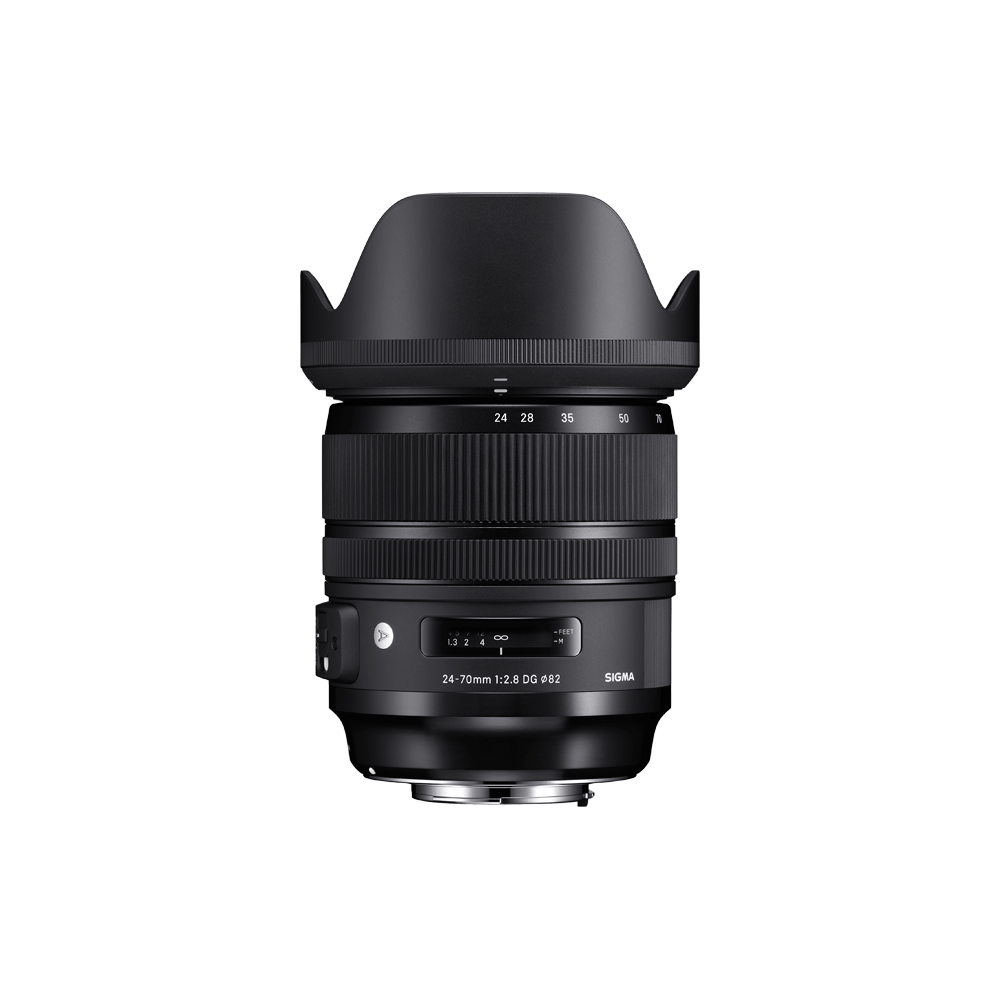
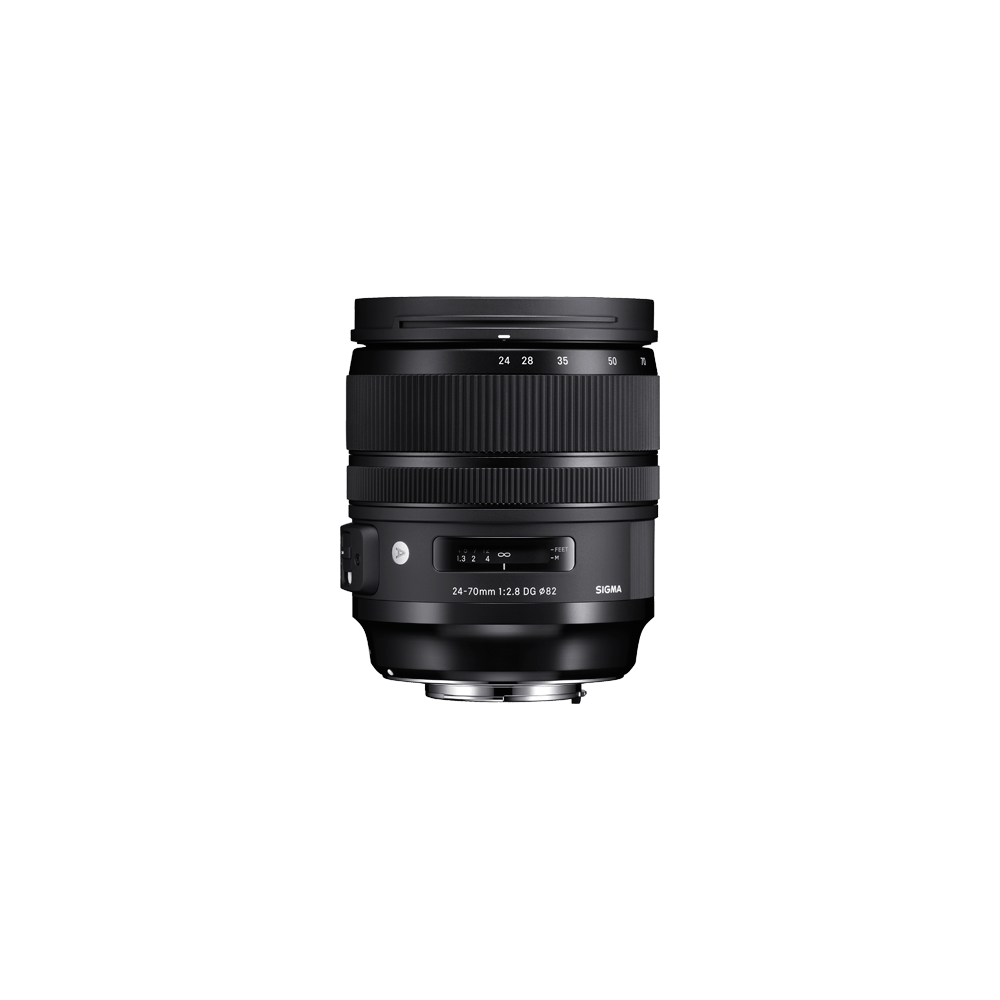
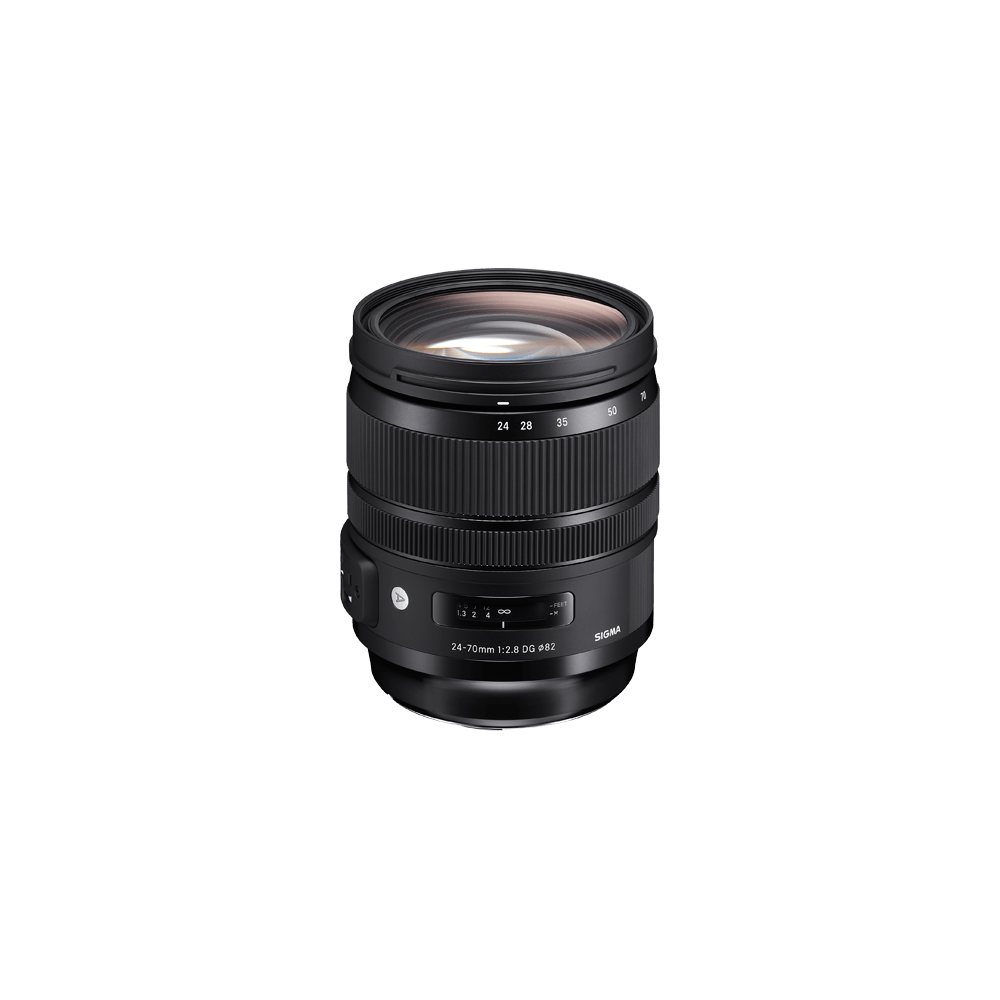
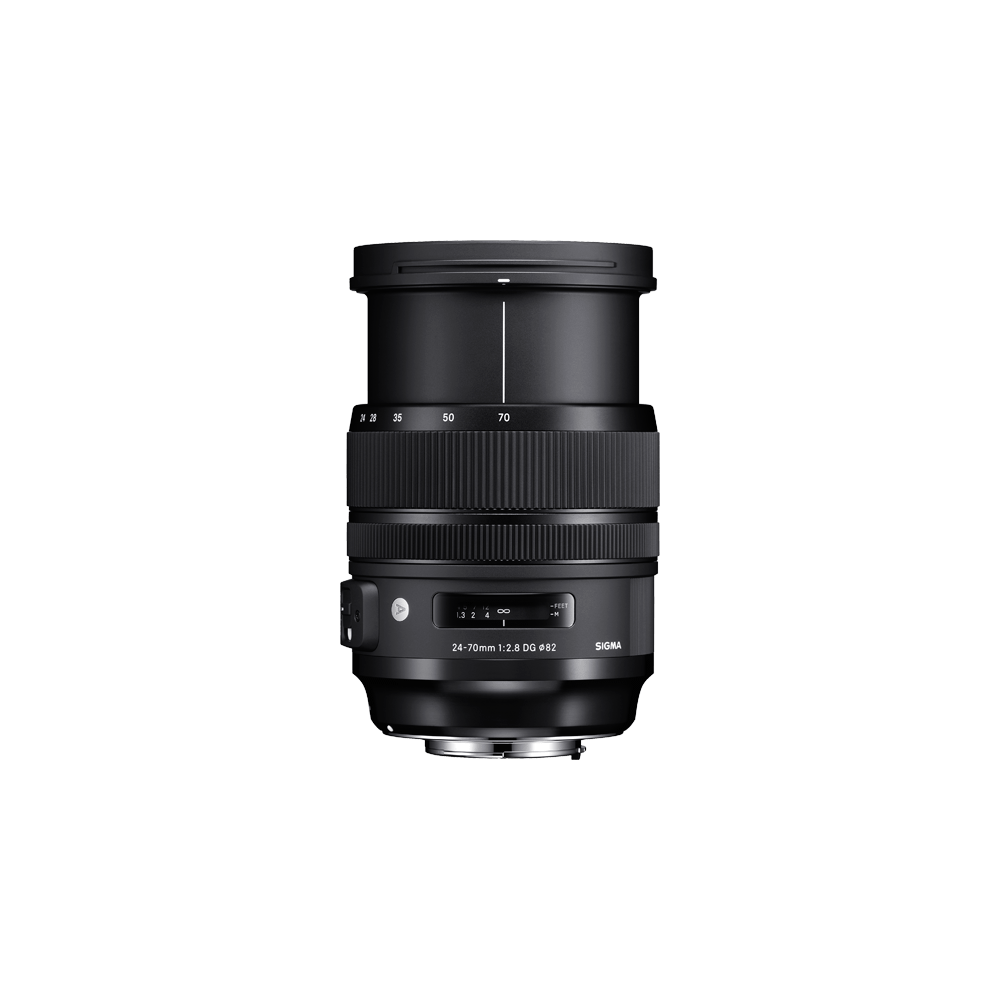




Art
24-70mm F2.8 DG OS HSM
Available mounts
- SIGMA SA-mount
- Canon EF mount
- Nikon F mount
-
Camera Type
DSLR
-
Corresponding Mount
SIGMA SA-mount, Canon EF mount, Nikon F mount
-
Sensor Format
Full-frame [DG]
-
Lens Construction
19 elements in 14 groups
-
Angle of View
84.1° - 34.3°
-
Number of Diaphragm Blades
9 (Rounded diaphragm)
-
Minimum Aperture
F22
-
Minimum Focusing Distance
37cm / 15in.
-
Maximum Magnification Ratio
1:4.8
-
Filter Size
φ82mm
-
Dimensions (Diameter × Length)
φ88mm × 107.6mm / φ3.5in. × 4.2in.
*The length of a lens is measured from the filter surface to its mount.
-
Weight
1,020g / 36.0oz.
-
Edition Number
A017
The three-digit code on the surface of the lens is to indicate the year the lens was first released.
(Since it is different from the year of manufacture, the release year and edition number may not match depending on the mount.) -
Supplied Accessories
・Case
・LENS HOOD LH876-04
・FRONT CAP LCF-82mm III
・REAR CAP LCR II -
Mount / Product Barcode
SIGMA SA-mount:00-85126-57656-1
Nikon F mount:00-85126-57655-4
Canon EF mount:00-85126-57654-7
-
Camera Compatibility
LINK
-
*Values are for Sigma SA-mount
*The Nikon mount version of this lens includes an electromagnetic diaphragm mechanism. Functionality may be limited on some camera bodies.
*For Nikon F mount cameras, please see (*)Nikon camera compatibility(*)Nikon F mount camera compatibility
Lenses for Nikon F mount with an electromagnetic diaphragm mechanism can be used with the following cameras.
Z7Ⅱ※,Z7※,Z6Ⅱ※,Z6※,Z5※,Z50※,D6, D5, D4S, Df, D850, D810, D810A, D780, D750, D610, D500, D7500, D7200, D7100, D5600, D5500, D5300, D5200, D5100, D5000, D3500, D3400, D3300, D3200, D3100
※Can be used with the Nikon "Mount Adapter FTZ" attachedBefore using with one of the cameras listed below, please update the lens to the latest firmware version.
D4, D3X, D3S, D3, D800, D800E, D700, D600, D300S, D300, D7000
* The lens cannot be used with the cameras not listed above (including film single‐lens reflex cameras).
-
The large-diameter standard zoom ideal for today’s ultra-high-megapixel digital cameras
Sigma’s Art line: a focus on high resolution
To fulfill the uncompromising image quality standard of the Art line, this lens features a power distribution that has been optimized in exacting detail. This is the lens for those who desire consistent resolution at maximum F2.8 brightness or lower and complete control of the beautiful bokeh effect.
-
Outstanding optical performance
Three SLD glass lens elements and four aspherical lens elements help minimize optical aberrations. To ensure outstanding image quality from the center to the edges of the photograph, the optical system minimizes coma, which causes points of light to streak, and transverse chromatic aberration, which cannot be corrected by adjusting the aperture. The optical system also minimizes distortion, which can be particularly evident in wide-angle shots, resulting in excellent optical performance throughout the zoom range.
-
Incorporating advanced aspherical lens processing technology
Aspherical lenses necessitate refined expertise in the design and manufacturing of advanced, high-performance lenses. Sigma’s representative products to feature this technology were the Sigma 12-24mm F4 DG HSM | Art and Sigma 14mm F1.8 DG HSM | Art, which both incorporated large ⌀80mm aspherical lenses as their front lens element.
Building on the success of these predecessors, the Sigma 24-70mm F2.8 DG OS HSM | Art incorporates an aspherical lens element that helps achieve extremely high resolution. This element is much thicker at the center than the edges, and forming its unusual shape is a feat of manufacturing technology. Moreover, Sigma processes the surface of this aspherical lens element with ultra-precise tolerances that are measured in hundredths of a micrometer. This extremely fine surface allows the Sigma 24-70mm F2.8 DG OS HSM | Art to deliver a very natural and smooth bokeh effect, without the visible concentric rings that afflict typical aspherical lens elements.
-
A 24-70mm F2.8 lens that meets the high standards of the Art line
Sigma has continuously pioneered 24-70mm F2.8 lenses that are a step ahead of the times. The first model of this specification, Sigma 24-70mm F2.8 EX DG ASPHERICAL DF, launched in 2001. Representing the fourth generation of the family, the new Sigma 24-70mm F2.8 DG OS HSM | Art accomplishes a challenging feat in optical design: incorporating optical stabilizer functionality in a large-diameter standard zoom. By leveraging all of its design and manufacturing expertise, Sigma has ensured that this new lens fulfills the uncompromising requirements of the Art line for image and build quality.
-
Bokeh that is a cut above
At wide-open aperture, this lens offers outstanding photographic expression. The area in focus is extremely sharp, while the background exhibits a beautiful bokeh effect with only slight spherical aberration. Since large-diameter zoom lenses are often used at wide-open aperture, Sigma has paid close attention to the shape of the bokeh, aiming for perfect circularity.
-
Exclusive low-dispersion glass
The degree to which light is refracted by glass depends on the light’s wavelength. This fact causes different colors of light to focus at slightly different points. The result is chromatic aberration, the color fringing that is particularly noticeable in telephoto lenses. Most chromatic aberration can be removed by combining a high-refractivity convex lens element with a low-refractivity concave element. Yet residual chromatic aberration known as “secondary spectrum” may still remain. To minimize this secondary spectrum, which can be a serious issue with conventional lenses, Sigma lenses feature up to three types of exclusive low-dispersion glass offering superior performance: ELD (Extraordinary Low Dispersion), SLD (Special Low Dispersion) and FLD (“F” Low Dispersion). In particular, FLD glass offers ultra-low dispersion in combination with high transmittance and the anomalous dispersion characteristics of fluorite. Meticulous deployment of these types of exclusive low-dispersion glass and optimization of power distribution gives Sigma lenses superlative image rendition undiminished by residual chromatic aberration.
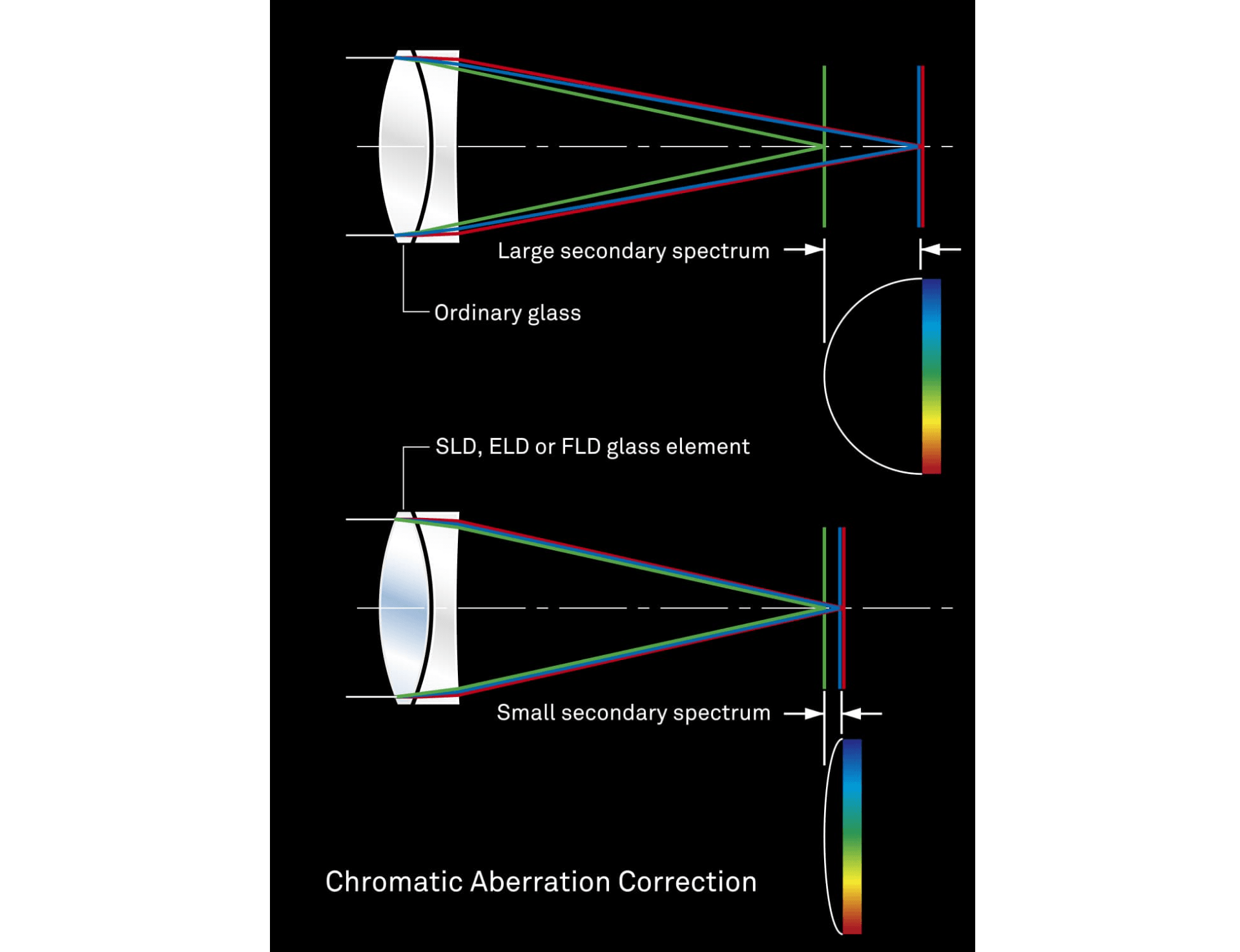
-
Designed to minimize flare and ghosting
From the start of the design process, Sigma measured flare and ghosting to establish an optical design that is resistant to strong incidental light sources such as backlight. At the prototyping stage, Sigma used not only simulations but actual photographic experiments to assess flare and ghosting under multiple criteria, identify the causes of these issues under a wide range of situations, and take measures to mitigate them. In addition, Sigma’s Super Multi-Layer Coating helps further reduce flare and ghosting and provide sharp, high-contrast images even in backlit conditions.
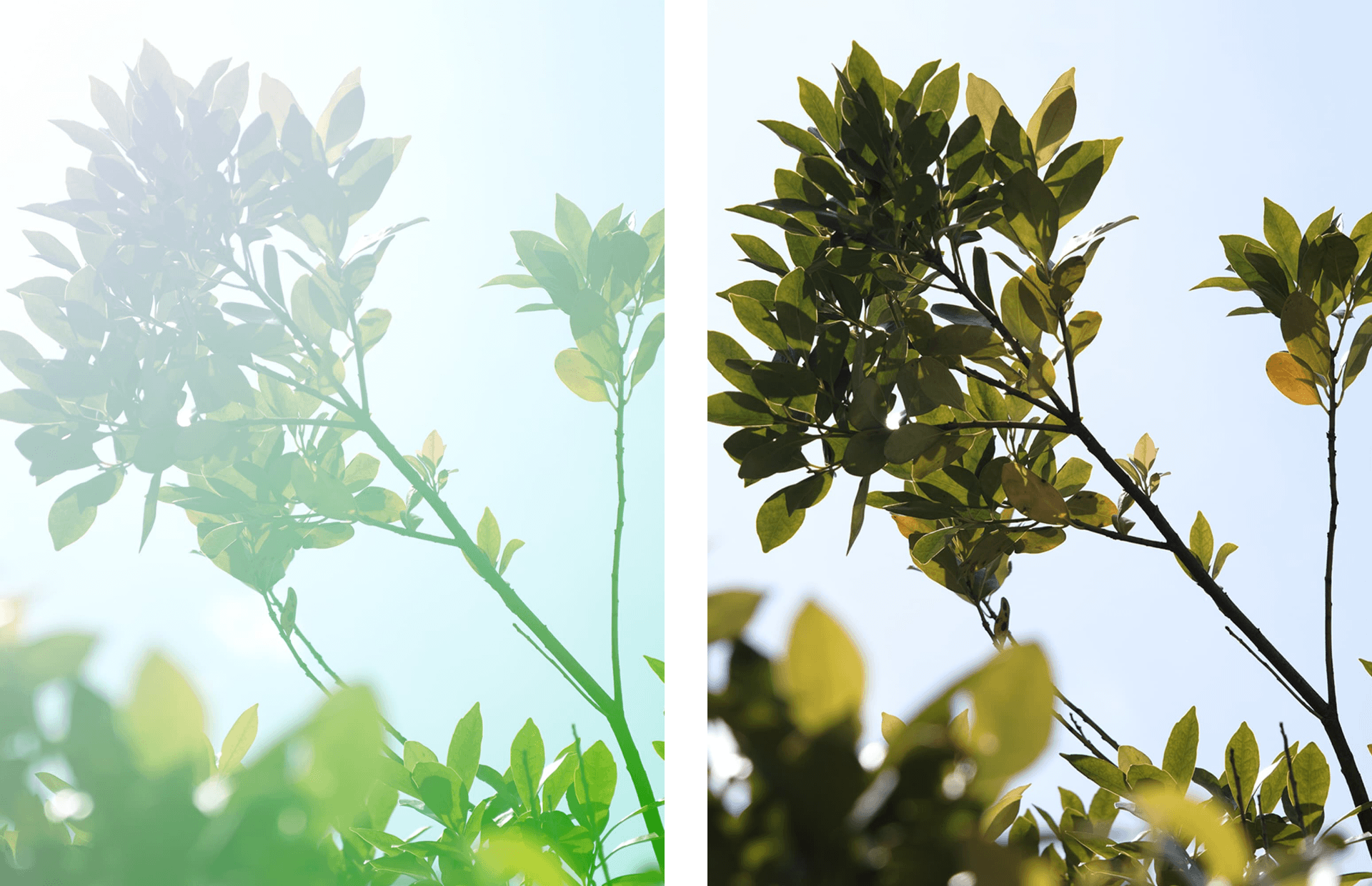
-
OS and other features for success on any shoot
OS functionality, newly designed HSM, mount with dust and splash resistant structure, electromagnetic aperture control (for Nikon), and more
This lens has all the features and functions photographers need to be successful on a wide variety of shoots. In addition to outstanding image quality, this lens offers autofocus, construction that minimizes the incursion of dust and debris, an optical stabilizer (OS) function, and more. To make this lens as easy to use as possible by photographers in all fields, it features not only Sigma’s most advanced mechanical systems but also the company’s latest software.

-
Incorporating the OS function for success on any shoot
Designed for use in a wide variety of situations, the optical stabilizer (OS) offers a powerful stabilization effect of 4 stops*.
* Based on CIPA guidelines. Measured at the telephoto setting on a camera with a 35mm full-size image sensor.
-
Lens barrel designed for high rigidity
Since large-diameter standard zoom lenses tend to serve as a go-to lens and see frequent use, the Sigma 24-70mm F2.8 DG OS HSM | Art is designed to stand up to the challenging shooting environments that pros encounter. To this end, the lens barrel contains a large amount of metal, while the external moving parts feature thermally stable composite (TSC), which is resistant to thermal expansion and contraction. This structure contributes not only to the outstanding optical performance of the lens but also to its high rigidity and confidence-inspiring build quality.
-
Newly designed HSM for fast AF performance
The newly designed hypersonic motor (HSM) offers 1.3 times the torque of its predecessor. Even at low speeds, it offers exceptionally stable performance.
-
Nikon electromagnetic diaphragm mechanism included
The Nikon mount version of this lens includes an electromagnetic diaphragm mechanism that allows it to receive the appropriate signals from the camera body. This feature ensures precision diaphragm control and stable Auto Exposure (AE) performance during continuous shooting.
-
Fast AF with full-time manual focus
Full-time manual focus function allows the lens to be switched to manual focus simply by rotating the focus ring.
Note: The operation of full-time MF may vary based on mount type.
-
Mount with Dust and Splash Resistant Structure
Since the area of the lens most vulnerable to dust and other foreign bodies is the mount, rubber sealing* helps provide peace of mind. In addition, the front lens element features a water- and oil-repellant coating that helps the lens perform well in the rain, near water, and in other challenging conditions.
* Except for Sigma mount
-
Rounded diaphragm
The 9-blade rounded diaphragm creates an attractive blur in the out-of-focus areas of the image.

-
High-precision, rugged brass bayonet mount
The brass mount combines high precision with rugged construction. Its treated surfaces and enhanced strength contribute to the exceptional durability of the lens.
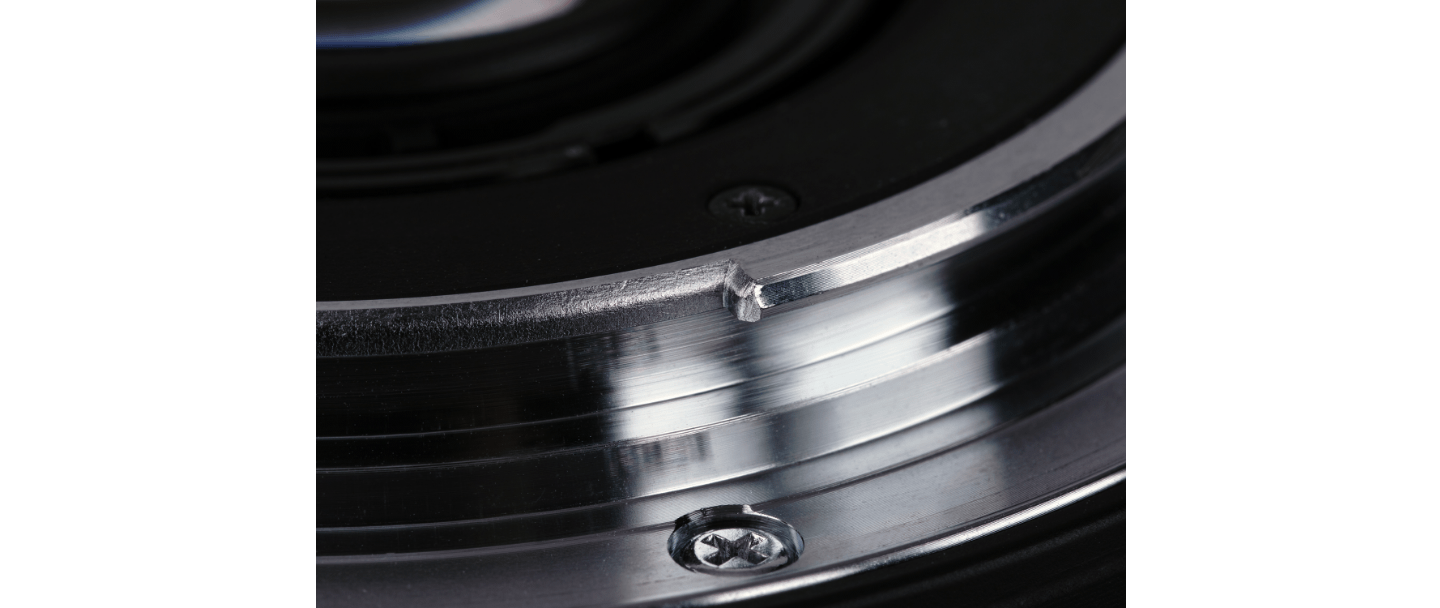
Lens construction
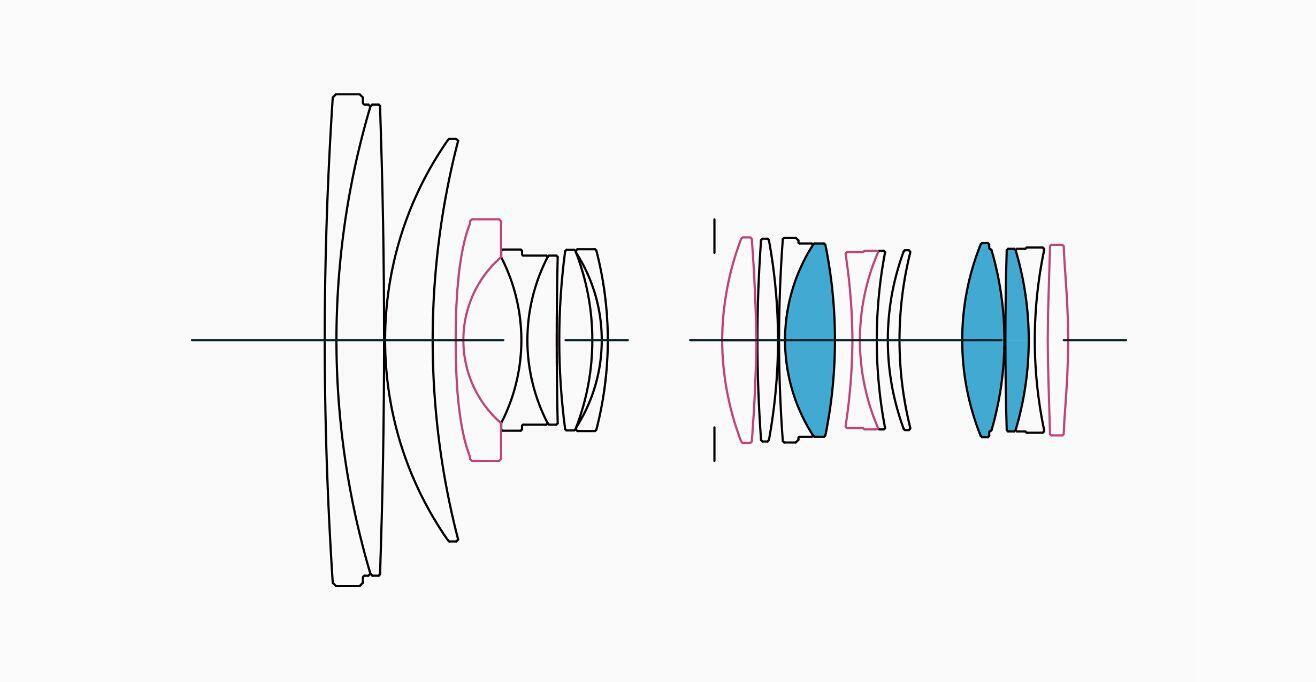
SLD glass
Aspherical lens
MTF Chart
The MTF (Modulation Transfer Function) is one of the measurements for evaluating a lens’ performance, and it shows how faithfully the contrast of the subject can be reproduced on the image plane. The horizontal axis shows the image height (distance from the center of the image in mm) and the vertical axis shows the contrast value (maximum value is 1).
The closer the 10 line pairs/mm curve is to 1, the higher the contrast and clarity of the lens is, and similarly, the closer the 30 line pairs/mm curve is to 1, the better the resolution and sharpness of the lens is.
*The MTF chart depicts the result at the wide-open aperture.
*For mirrorless lenses that support distortion correction, the horizontal axis shows the image height equivalent to when an L-Mount lens is attached to a Sigma L-Mount camera with distortion correction applied. (The effect of distortion correction may differ depending on the mount and camera used.)
*The spatial frequency indicates the variation on the image plane before distortion correction is performed.
-
Spatial frequency
S:Sagittal Line
M:Meridional Line
-
10lp/mm
-
30lp/mm
Diffraction MTF
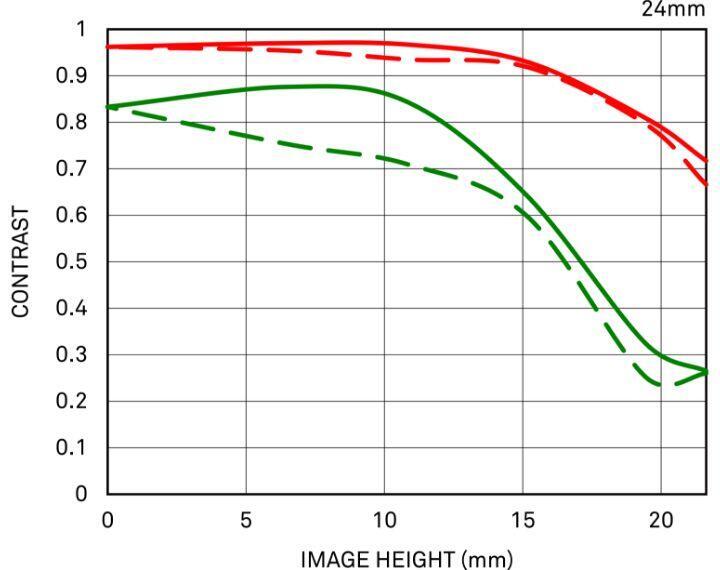
Diffraction MTF
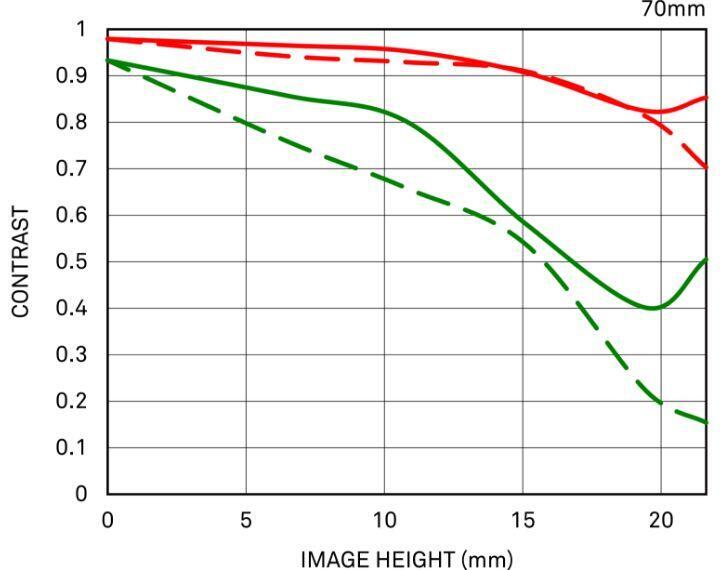
Geometrical MTF
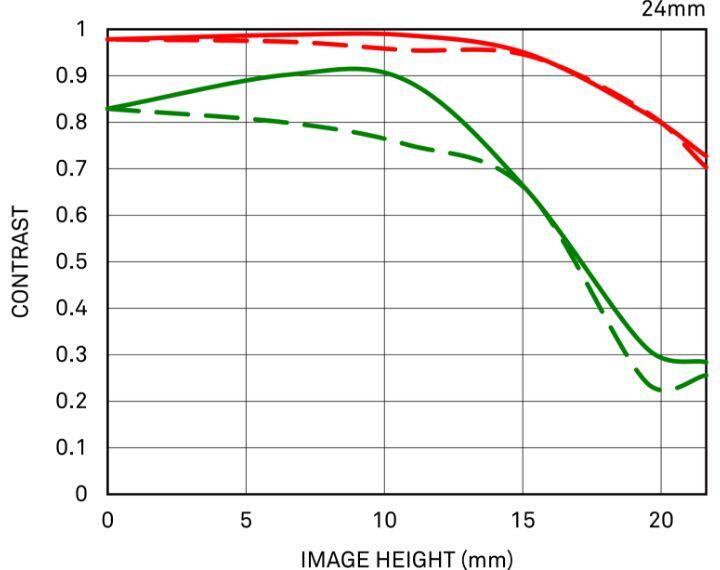
Geometrical MTF
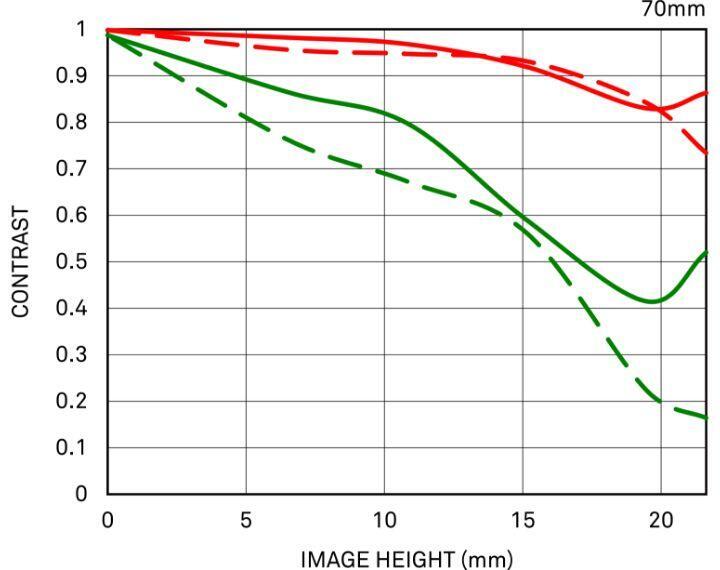
Distortion
effective distortion
When you take a picture of a lattice pattern, it will appear as the blue dotted line shows. The red line illustrates how the lattice pattern will appear in the actual picture when any lens distortion is taken into account.
relative distortion
In this chart, the horizontal axis shows the ideal image height (the distance from the center to the edge of the image [mm]). The vertical axis shows the extent of distortion. The extent of distortion is represented by how much Y, which is the actual image height, grows (or shrinks) against Y0 which is the ideal image height.
When you take the picture of a square object, if the distortion amount shows a minus value, the image will be seen as expanded (Barrel distortion). If the distortion amount is a plus value, it will be seen as a recessed (Pincushion distortion). When the distortion value is close to 0, the appearance of distortion is very minimal.
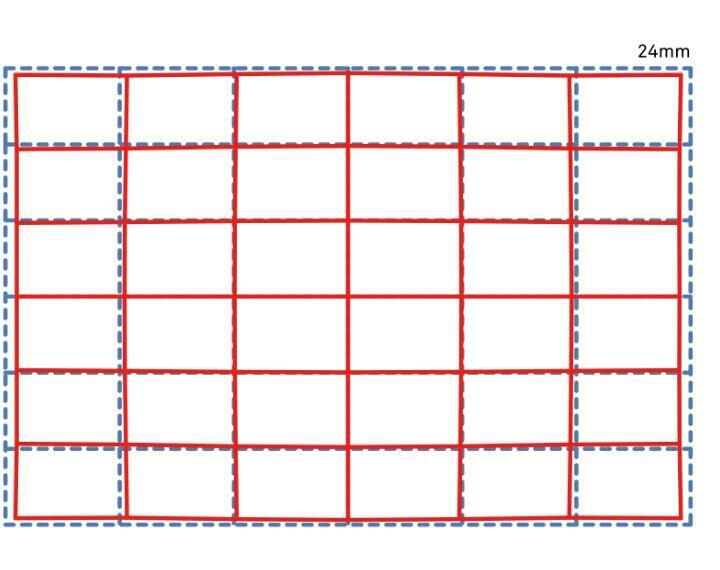
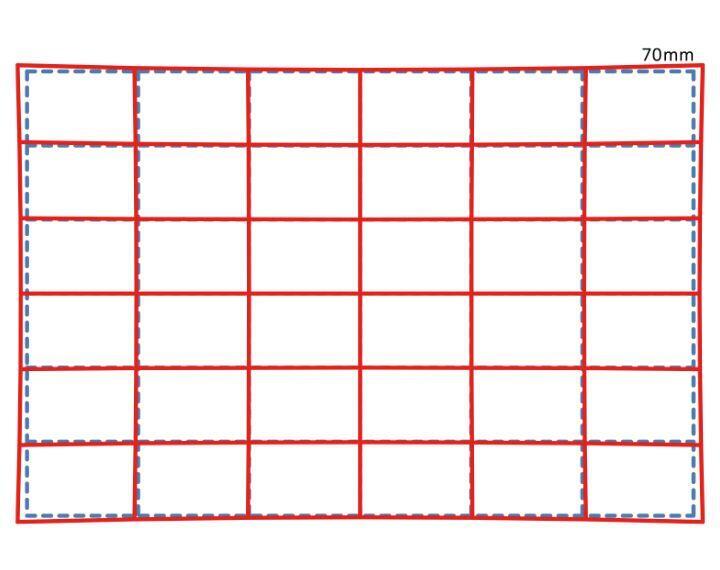

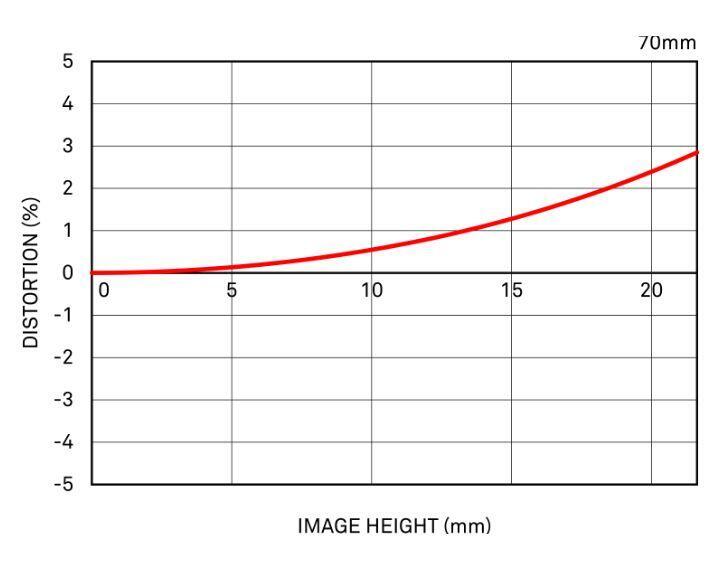
Vignetting
The horizontal axis shows the image height (the distance from the center to the edge of the image [mm]).The vertical axis shows the amount of light in the image (based on the amount of light in the image center being 100%). If the peripheral amount of light is lower than the center, the four corners of image will be darker (vignetting).
-
F2.8
-
F5.6
-
F11
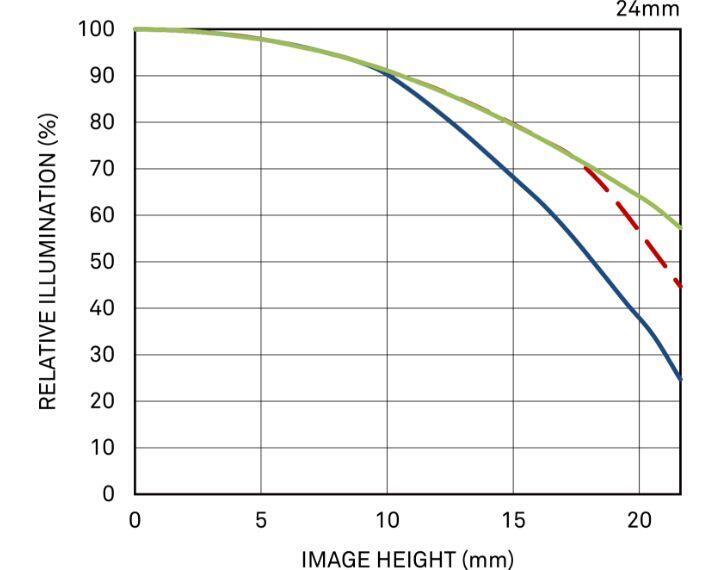
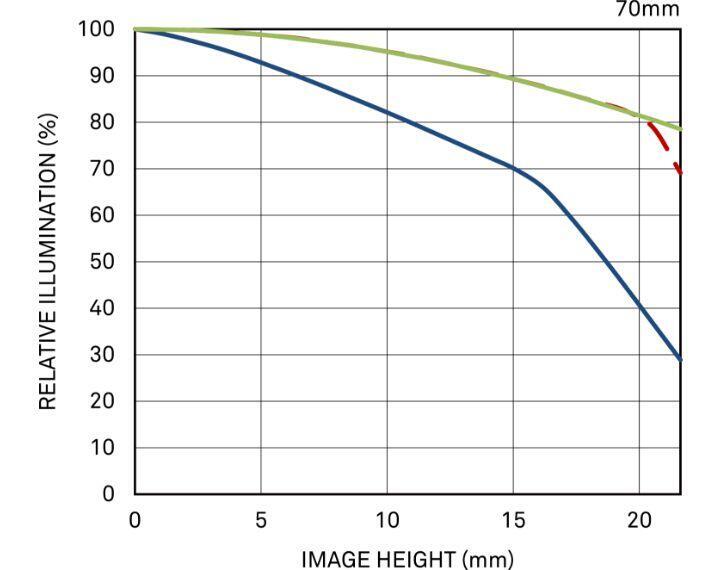
The definitive large-diameter
zoom lens for any shoot
All-new 24-70mm F2.8
The performance and functionality that pros in all fields require
What photographers demand from the 24-70mm F2.8 specification is much more than outstanding image quality. They want all the features that make this a go-to lens for a wide range of photographic opportunities, including optical design ideal for the latest ultra-high-megapixel digital cameras, hypersonic motor (HSM) for high-speed autofocus, optical stabilizer (OS) with powerful stabilization effect, mount with dust and splash resistant structure, and a metal barrel for a stable, rigid feel. This all-new 24-70mm F2.8 lens from Sigma delivers the performance and functionality that help pros succeed in news, nature, and many other fields of photography.
Art line delivers high-level artistic expression
Sigma is organizing all its interchangeable lenses into three product lines: Contemporary, Art, and Sports, each with a distinctive concept. Designed with a focus on sophisticated optical performance and abundant expressive power, our Art line lenses deliver high-level artistic expression. Offering astonishing rendering performance that meets the highest standard, they are perfect for landscapes, portraits, still-lifes, close-ups, and casual snaps. They are made for the kind of photography that unleashes the inner artist. A powerful ally in every genre of photography, Sigma’s Art line lenses excel both in the studio for formal works and outdoors for impressive shots of architecture, starry skies, and many other scenes.